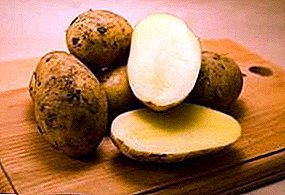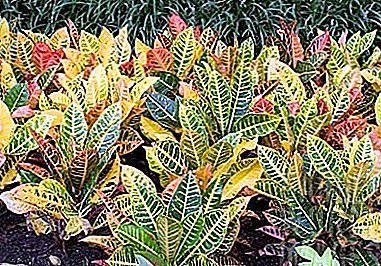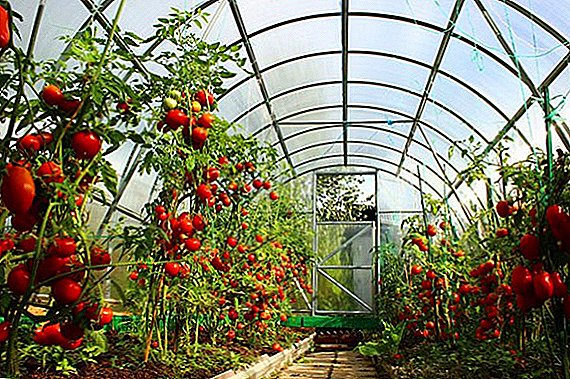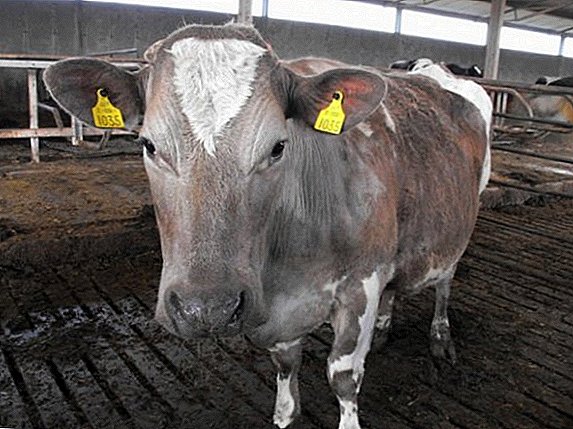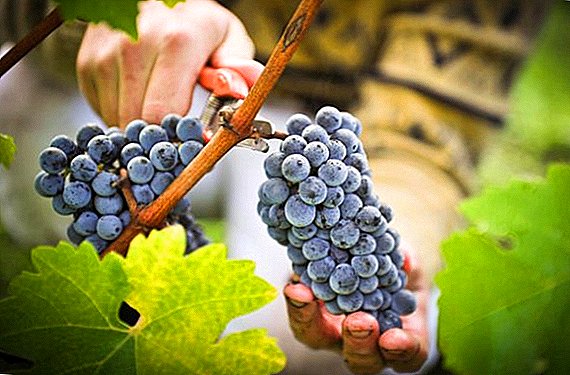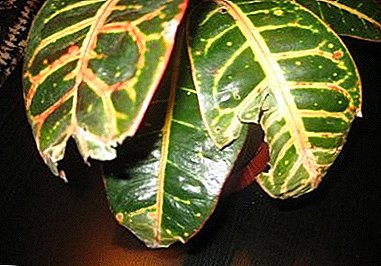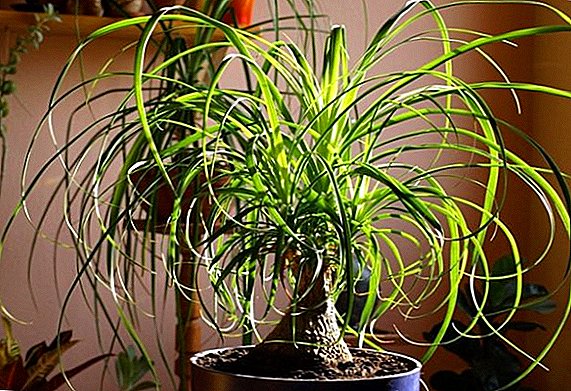 Nolina, or bokarneyya - a decorative leafy plant of the Agave family. Scientists still have not come to the same opinion, and sometimes refer it to Dratsenov. His homeland is the southern part of North America. In nature, it can reach a ten-meter height.
Nolina, or bokarneyya - a decorative leafy plant of the Agave family. Scientists still have not come to the same opinion, and sometimes refer it to Dratsenov. His homeland is the southern part of North America. In nature, it can reach a ten-meter height.
Did you know? Succulent got its name in honor of the breeder from France P. Nolin, who described this genus in 1803.Usually has a thickened downward trunk, in which moisture accumulates, and thin long leaves growing from one point.
Popular types of nolina
In nature, there are about 30 varieties of nolina. The most famous of them are:
- Nolina thin (Beaucarnea gracilis, Nolina gracilis) - has a spherical stem at the base, at the top of which there are bunches of very long and thin leaves. Sometimes it can bloom in red or pinkish flowers.
- Nolina sticking out (Beaucarnea stride, Nolina stride) - looks like a thin nolin, but has stiffer leaves.
- Nolina Lindemeira (Nolina lindheimeriana, Beaucarnea lindheimeriana) has a slightly pronounced trunk and a well-developed deciduous part. Refers to undersized species.
- Nolina longifolia (Nolina longifolia) in nature reaches several meters in height. It has a rounded trunk covered with thick corky bark. Pointed leaves are very long and tough.
- Nolina Nelson (Nolina nelsoni) reaches several meters in height, the trunk is almost not expressed. The leaves have a slightly bluish tint.
- Nolina Matapska (Nolina matapensis) refers to plants of average height. Old leaves do not fall off immediately, forming a "skirt" around the trunk.
- At home, Bocarnay bent is usually bred (Beaucarnea recurvata, Nolina recurvata). It has a “bottle-shaped” stem, on top of which bunches of dark green, hard, long, ribbon-shaped leaves are formed.

Did you know? Due to their appearance, people are called “bottle tree”, “elephant foot” and “horse tail”.

What conditions to create in the house for the "bottle tree"
Like all succulents, nolina is a very unpretentious plant, since it grows in nature under rather austere conditions.
Location and lighting
When choosing a place for the bokarnei, you should remember where the bottle tree grows in nature. This is usually the deserts of Mexico, so it is advisable to place a nolina on the south or southwest windows. It needs intensive lighting, with its lack of power, the trunk begins to lean towards the light source.
Also read about other representatives of the succulents: aihrizone, havortia, agave, aloe, hoya, kalanchoe, jerk, young, lithops, cacti.
Temperature
In the natural habitat of Nolina, the winter temperature is usually not lower than 10 ° C, and in summer it can rise to 50 ° C in the sun. Thanks to this variation bulgaria hardy to temperature fluctuations. The optimum range for it will be from 20 to 25 ° C. In winter, it is recommended to lower the temperature to 10 ° C due to the fact that the plant goes into a resting phase.
How to care at home
Although nolina does not need special conditions, the following recommendations will be useful to you in order to form a characteristic shape for the plant (bottle stem), with which it attracts attention.

Watering and humidity
Since the plant lives in the desert latitudes, watering nolina at home is rarely needed. Excessive watering for it is much more dangerous than drying. In the summer it is enough once a week, in the winter the interval is increased. Preference is better to give the lower irrigation, immersing the bokarnyu in a container of water for 20-30 minutes.
Important! In the summer, nolina is recommended to be carried out to the fresh air, but care must be taken to ensure that it does not fall under the rain.Nolina steadily tolerates drought and insufficiently humid air, therefore spraying is not a necessary condition for keeping. Leaves can be wiped with a damp sponge.
Fertilization
Top dressing for nolina is not necessary at all, it grows quite well and grows quickly without it. If fertilized, it is only during the period of active growth and no more than once a month after abundant watering. Complex mineral fertilizers are suitable for Bulgarian. The concentration of the solution must be made two times less than indicated in the instructions.
Transplant: soil and pot for nolina
 Juveniles are transplanted once every two years, adult bokarnei - once every 5 years. The root system is superficial, for this reason the pot for the nolina is better to buy a flat and wide, always with holes for drainage.
Juveniles are transplanted once every two years, adult bokarnei - once every 5 years. The root system is superficial, for this reason the pot for the nolina is better to buy a flat and wide, always with holes for drainage.
Preference is better to give a ceramic pot, so the evaporation of excess moisture will occur through the side walls. At the bottom it is necessary to lay a layer of expanded clay, pour half of the substrate, lay the plant, carefully spreading the roots on the surface of the ground, fill the ground.
Important! When transplanting nolina make sure that the roots are located strictly in the horizontal plane, and do not bury the base of the trunk.Soil for the bokarnei need loose. Two substrate variants will do: Peat, sand, leaf earth (1: 2: 1); Leaf ground, humus, peat, turf ground (1: 1: 1: 1)
Breeding methods
Breeding nolina at home - quite troublesome. The main method - sowing seeds, rarely use reproduction lateral processes.
Seeds
Sow the seeds in late winter - early spring. Before that, they are soaked in water for 48 hours. Floated seeds are not suitable for further use. Next, the seeds are planted in small containers filled with sand and peat substrate, which are then covered with glass and removed in a bright, warm place.

Seeds germinate within 2-3 weeks. As soon as the first leaves appear, the glass is removed. Rooted and mature shoots are transplanted into the soil for nolina. Growing nolins from seeds is a very long process, the young succulent grows extremely slowly.
Lateral processes
Occasionally nolina gives side shoots. This process should be cut as close as possible to the base, sprinkle with cinnamon or activated charcoal and allow to dry for 5 hours. Then the shoot is planted in the ground and cover with a jar.

The pot is placed in a warm place, occasionally aerating the plant. The shoot before planting can be soaked in a phytohormone solution - this will accelerate the formation of roots.
And also read about the cultivation of other indoor plants: fern Asplenium, hamedorea, eustoma, orchid, date palm, diploadiya, croton, poinsettia, Brugmancia, nightshade, cheflera.
Possible problems with growing
Despite the fact that nolina is considered to be a very unpretentious plant, a number of difficulties and questions may arise when caring for it. For example, why nolini dry leaf tips. Let us dwell on possible problems.
- Sluggish darkened leaves - a sign of insufficient lighting. In this case, the bokarnayu need to put on a more lighted window or to organize additional lighting.
- Brown, dry tips of the leaves are the norm for adult plants. If you want to avoid this, the plant must be sprayed.
- A soft stem indicates plant rotting due to excess moisture. To save such a plant is extremely difficult.
- The leaves turn pale, and new ones grow smaller - nolina needs a more spacious pot. It may also indicate low light or high temperature.
- The barrel shrivels and shrinks - this means that the plant has exhausted moisture reserves and requires watering.
- The lower leaves dry up and fall off - if this happens gradually, then the process is natural. Fully dried leaves must be removed.

Pests do not like nolina, because its leaves are too hard, and care at home from this point of view is simplified. However, it can sometimes be struck by a spider mite, thrips, and scale insects. Affected leaves turn yellow, deform and die. Parasites are mechanically removed, and then the plant is treated with insecticides.
Did you know? Nolina pests include ... domestic cats. Bokarnei leaves for them - real delicacy!
Beneficial features
In addition to aesthetic beauty, it is useful to keep Nolina in a residential area, since it improves the microclimate, saturating the air with oxygen and ozone. Bottle tree strengthens the human immunity and a positive effect on the nervous system. Lately, the boutique is popular among designers: they love to decorate modern interiors and offices with this plant.
Due to its unpretentiousness nolin easily take root in any home and will certainly be pleasing to the eye with its unusual appearance.


